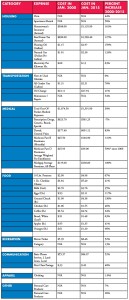(Alexandria, VA) – Social Security beneficiaries have lost 22 percent of their buying power since 2000, according to the 2015 Survey of Senior Costs by The Senior Citizens League (TSCL). The findings show a dramatic drop in inflation over the past year, due almost entirely to the drop in oil prices. “The deflationary trend, while good news for some consumers, spells trouble ahead next year for retired and disabled beneficiaries who depend on Social Security for most of their income,” says TSCL Chairman Ed Cates.
In most years, Social Security beneficiaries receive a small increase in their Social Security checks, intended to help them keep up with rising costs. But according to the 2015 TSCL survey of typical senior costs, since 2000 the Cost of Living Adjustment (COLA) has increased benefits just 43 percent while typical senior expenses have jumped 74 percent. Recently the Social Security Trustees confirmed that there would be no annual COLA for 2016 — which TSCL earlier forecast in May.
Inflation has been at historic lows in recent years and seniors received a COLA of just 1.7 percent this year. “While there’s been some temporary improvement in the buying power of Social Security benefits recently, the drop in inflation is now so large that there is no COLA expected for 2016,” says TSCL Chairman Ed Cates. “The government will announce the COLA for 2016 in October, ” he adds. Going without any COLA has long-term consequences resulting in lower total retirement income,” Cates says. “This problem also affects military retirees and others who receive COLA adjusted benefits,” he adds.
According to the TSCL survey, people with average Social Security benefits in 2000 received $816 per month, a figure that rose to $1,166.30 by 2015. However, those individuals would require a Social Security benefit of $1,419.00 per month in 2015 just to maintain the same buying power they had when they first retired, the study found.
The study examined the increase in costs of 34 key items between 2000 and January 2015. The items were chosen because they are typical of the costs seniors must bear. Of the 34 costs analyzed, 22 exceeded the amount of increase in the COLA over the same period. The selected items represent eight categories, weighted by approximate expenditure.
“This study illustrates why budget proposals that would cut the growth of COLAs would put millions of older and disabled Americans at risk of insufficient income to cover more growing expenses,” says Cates. “To put it in perspective, for every $100 worth of expenses seniors could afford in 2000, they can afford just $78 today,” Cates adds.
A majority of the 59 million senior and disabled Americans who receive Social Security depend on it for at least 50 percent of their total income, and one in three beneficiaries relies on it for 90 percent or more of his or her total income.
To help the protect buying power of benefits, The Senior Citizens League supports legislation that would base COLAs on the Consumer Price Index for the Elderly and emergency legislation to provide COLA and Medicare premium relief for seniors in 2016.
###
With 1.2 million supporters, The Senior Citizens League is one of the nation’s largest nonpartisan seniors groups. Its mission is to promote and assist members and supporters, to educate and alert senior citizens about their rights and freedoms as U.S. Citizens, and to protect and defend the benefits senior citizens have earned and paid for. The Senior Citizens League is a proud affiliate of The Retired Enlisted Association. Visit www.SeniorsLeague.org for more information.
ALSO AVAILABLE TO JOURNALISTS: STUDY METHODOLOGY AND INTERVIEWS


